Jackson, Pollock, Jackson Pollock
On the floor I am more at ease, I feel nearer, more a part of the painting, since this way I can walk around in it, work from the four sides and be literally `in' the painting.
-- Jackson Pollock, 1947.
Pollock, Jackson (1912-56). American painter, the commanding figure of the Abstract Expressionist movement.
He began to study painting in 1929 at the Art Students' League, New York, under the Regionalist painter Thomas Hart Benton. During the 1930s he worked in the manner of the Regionalists, being influenced also by the Mexican muralist painters (Orozco, Rivera, Siqueiros) and by certain aspects of Surrealism. From 1938 to 1942 he worked for the Federal Art Project. By the mid 1940s he was painting in a completely abstract manner, and the `drip and splash' style for which he is best known emerged with some abruptness in 1947. Instead of using the traditional easel he affixed his canvas to the floor or the wall and poured and dripped his paint from a can; instead of using brushes he manipulated it with `sticks, trowels or knives' (to use his own words), sometimes obtaining a heavy impasto by an admixture of `sand, broken glass or other foreign matter'. This manner of Action painting had in common with Surrealist theories of automatism that it was supposed by artists and critics alike to result in a direct expression or revelation of the unconscious moods of the artist.
Pollock's name is also associated with the introduction of the All-over style of painting which avoids any points of emphasis or identifiable parts within the whole canvas and therefore abandons the traditional idea of composition in terms of relations among parts. The design of his painting had no relation to the shape or size of the canvas -- indeed in the finished work the canvas was sometimes docked or trimmed to suit the image. All these characteristics were important for the new American painting which matured in the late 1940s and early 1950s.
 Male and Female
Male and Female
1942 (240 Kb); Oil on canvas, 73 1/4 x 49 in; Philadelphia Museum of Art
 The Moon-Woman
The Moon-Woman
1942 (170 Kb); Oil on canvas, 69 x 43 in; Peggy Guggenheim Collection, Venice
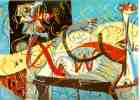 Stenographic Figure
Stenographic Figure
1942 (180 Kb); Oil on canvas, 40 x 56 in; The Museum of Modern Art, New York
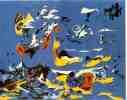 Blue (Moby Dick)
Blue (Moby Dick)
c. 1943 (150 Kb); Gouache and ink on composition board, 18 3/4 x 23 7/8 in; Ohara Museum of Art, Kurashiki
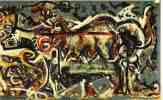 The She-Wolf
The She-Wolf
1943 (230 Kb); Oil, gouache, and plaster on canvas, 41 7/8 x 67 in; The Museum of Modern Art, New York
 Eyes in the Heat
Eyes in the Heat
1946 (320 Kb); Oil on canvas, 54 x 43 in; Peggy Guggenheim Collection, Venice
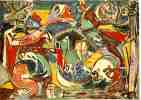 The Key
The Key
1946 (270 Kb); Oil on canvas, 59 x 84 in; The Art Institute of Chicago
 The Tea Cup
The Tea Cup
1946 (230 Kb); Oil on canvas, 40 x 28 in; Collection Frieder Burda, Baden-Baden
 Shimmering Substance
Shimmering Substance
1946 (280 Kb); Oil on canvas, 30 1/8 x 24 1/4 in; The Museum of Modern Art, New York
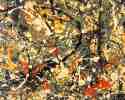 Number 8, 1949 (detail)
Number 8, 1949 (detail)
1949 (280 Kb); Oil, enamel, and aluminum paint on canvas; Neuberger Museum, State University of New York
 Easter and the Totem
Easter and the Totem
1953 (150 Kb); Oil on canvas, 84 1/4 x 58 in; The Museum of Modern Art, New York
During the 1950s Pollock continued to produce figurative or quasi-figurative black and white works and delicately modulated paintings in rich impasto as well as the paintings in the new all-over style. He was strongly supported by advanced critics, but was also subject to much abuse and sarcasm as the leader of a still little comprehended style; in 1956 Time magazine called him `Jack the Dripper'.
By the 1960s, however, he was generally recognized as the most important figure in the most important movement of this century in American painting, but a movement from which artists were already in reaction (Post-Painterly Abstraction). His unhappy personal life (he was an alcoholic) and his premature death in a car crash contributed to his legendary status. In 1944 Pollock married Lee Krasner (1911-84), who was an Abstract Expressionist painter of some distinction, although it was only after her husband's death that she received serious critical recognition.